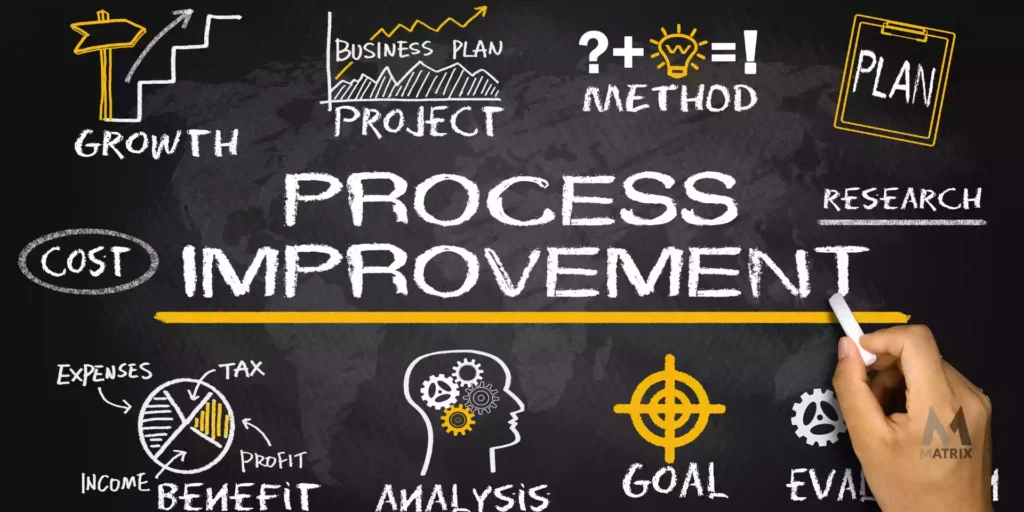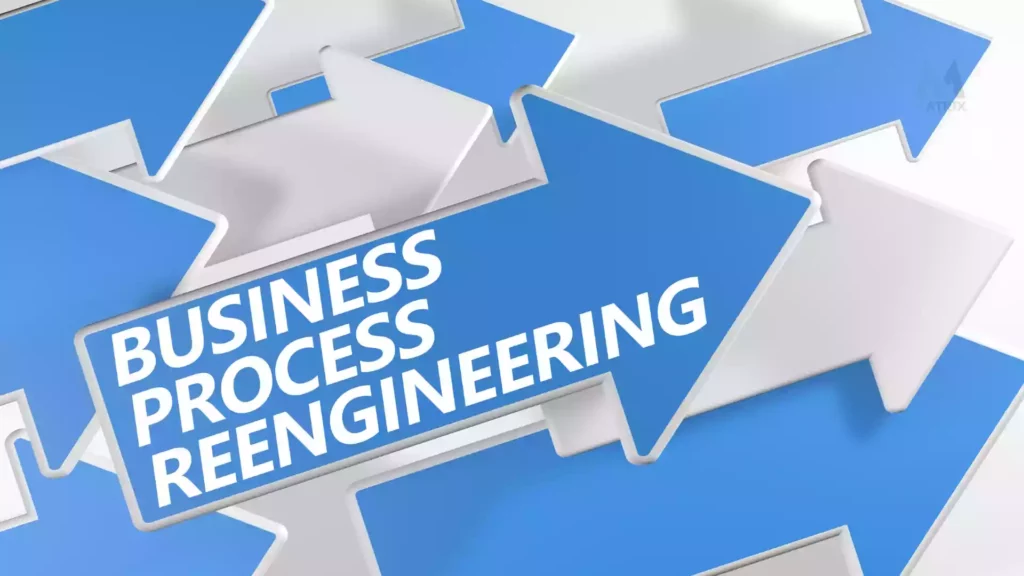Business Process Reengineering: Explosive Increase in Productivity
Business process reengineering can be a difficult process, but the results can be very beneficial for businesses driving explosive growth and jaw-dropping productivity gains.
In this article, we will focus on the executive responsible for the business process change management like strategy, people, and technology. You will find more than one example of business process reengineering in practice.
You will learn about the different aspects of BPR and how it can help your organization improve its operations.
Learn about improving business processes and begin driving true value. Start developing a culture of process excellence to eliminate inefficiencies and reduce cost.
Learn about improving business processes and begin driving true value. Start developing a culture of process excellence to eliminate inefficiencies and reduce cost.
BPR is also known as business process redesign, business transformation, or business process change management.
Read our article to learn more about business process change management and how it can benefit your company!
Business process reengineering (BPR) definition?

BPR is a strategy that organizations use to improve their operations. Business process reengineering is also known as BPO and BPR.
The goal of BPR is to identify areas within the company that is not performing as well as they should be and then make changes to those processes to improve efficiency and productivity.
BPR can be a difficult process, but the results can benefit businesses. When done correctly, BPR can help businesses increase their profits, reduce costs, and improve customer service.
Four steps are typically involved in business transformation:
- Identify the business processes that need to be improved.
- Analyze those processes to determine how they can be improved.
- Design the new, improved process.
- Implement the new process.
The executive responsible for the business process change management strategy is typically the chief executive officer (CEO) of the organization’s president.
The CEO is responsible for setting the organization’s direction and making sure that the organization’s resources are used in a way that will best achieve its goals. The president is responsible for day-to-day operations and ensuring that the organization’s policies are followed.
The business transformation strategy should be designed to meet the organization’s specific needs. It is important to keep in mind that not all businesses are the same and that each company has its own unique set of goals, objectives, and resources.
Business process change management involves radical redesigning core business processes to achieve dramatic improvements in productivity, cycle times, and quality.
72% of businesses say CRM offers them access to better customer data. Conversion rates may increase up to 300% using a CRM. CRM systems enhance customer retention rates, leading to a profit of 25% to 85%. CRM systems have the potential to increase revenue by 29%
If you’re like most business owners, you’re always looking for ways to improve your operations and increase your productivity. If you’re looking to take your business to the next level, you should consider business transformation.
BPR is a strategy that organizations use to improve their operations by identifying and correcting areas within the company that is not performing as well as they should be.
BPR can be a difficult process, but the results can benefit businesses. When done correctly, BPR can help businesses increase their profits, reduce costs, and improve customer service.
The four steps involved in BPR
The steps of reengineering will uncover problems and opportunities. Determine your scope of business process change management before starting or you will get bogged down. Go for the easy wins and incremental improvement in the first month.
The four steps involved in BPR are:
- Identify the business processes that need to be improved.
- Analyze those processes to determine how they can be improved.
- Design the new, improved process.
- Implement the new process.
Matrix Marketing Group typically takes a holistic approach and runs a gap analysis for gaps in strategy, people, processes, and technology. Any gap is causing a performance gap.
The executive responsible for the business transformation strategy is typically the chief executive officer (CEO) of the organization’s president.
The business process change management strategy should be designed to meet the organization’s specific needs.
It is important to keep in mind that not all businesses are the same and that each company has its own unique set of goals, objectives, and resources.
BPR involves radical redesigning core business processes to achieve dramatic improvements in productivity, cycle times, and quality.
The executive responsible for the business process change management
The CEO or president’s job for the business transformation strategy. They are responsible for setting the direction for the organization, making sure that resources are used in a way that will best achieve its goals, and ensuring that policies are followed.
It is important to keep in mind that not all businesses are the same and that each company has its own unique set of goals, objectives, and resources. When done correctly, BPR can help businesses increase their profits, reduce costs, and improve customer service.
How business transformation can help businesses improve their sales, marketing, and customer service operations
Business transformation can help businesses improve their sales, marketing, and customer service operations.
BPR can help businesses streamline their sales process, leading to increased efficiency and productivity. BPR can also help businesses improve their marketing efforts by helping them to identify and target their ideal customers.
Finally, BPR can also help businesses improve their customer service operations by helping them identify and correct areas within the company that is not performing as well as they should be.
The benefits of BPR for businesses
Reengineering can help businesses achieve many benefits, including increased profits, reduced costs, and improved customer service.
BPR can help businesses streamline their sales process, leading to increased efficiency and productivity. BPR can also help businesses improve their marketing efforts by helping them to identify and target their ideal customers.
Finally, BPR can also help businesses improve their customer service operations by helping them identify and correct areas within the company that is not performing as well as they should be.
Tips for implementing a successful BPR strategy

When implementing a successful BPR strategy, it is important to keep the following tips in mind:
- Make sure that the strategy is designed to meet your organization’s specific needs.
- Keep in mind that not all businesses are the same, and each company has its own unique set of goals, objectives, and resources.
- Make sure that the CEO or president of the organization is responsible for the strategy.
- Make sure that the strategy is designed to meet your organization’s specific needs.
- Keep in mind that not all businesses are the same, and each company has its own unique set of goals, objectives, and resources.
- Ensure that adequate resources are dedicated to the implementation of the strategy.
- Make sure that all employees are properly trained on the new processes.
- Monitor the strategy results regularly and make adjustments as necessary.
BPR can be a difficult process, but the results can benefit businesses. When done correctly, BPR can help businesses increase their profits, reduce costs, and improve customer service.
By following the tips above, you can help to ensure that your BPR strategy is successful.
What is the difference between reengineering and continuous improvement?

There is a lot of confusion between Business Process Reengineering and Continuous Improvement (CI). While both strategies are designed to improve the efficiency and productivity of an organization, they are quite different.
Business process redesign is a strategy used to overhaul the entire process of how a company operates. It is a radical change that involves identifying areas within the company that is not performing as well as they should be and then making changes to those processes to improve efficiency and productivity.
On the other hand, Continuous Improvement is a strategy that is used to improve the performance of individual processes within the company. It is a more gradual process that involves identifying areas where improvements can be made and then making those changes over time.
Both strategies can be effective in improving an organization’s operations, but they are suited for different purposes. Business process redesign is ideal for businesses looking to make a radical change in their operations. At the same time, Continuous Improvement is better for businesses looking for smaller, incremental improvements.
What are the business processes in a midmarket company?
Midmarket companies are typically smaller businesses looking to grow and expand their operations. They need a process in place to help them manage their growth. What are the core processes of a business? Do an assessment?
The following are some of the most common business processes in a midmarket company:
- Sales Process
- Marketing Process
- Customer Service Process
- Order Fulfillment Process
- Accounting and Finance Process
- Human Resources Process
These are just a few of the most common business processes in a midmarket company. Depending on your organization’s specific needs, there may be other processes that need to be in place. An assessment can help you determine which processes are most important for your business.
Redesigning your business processes can be a daunting task, but businesses need to improve efficiency and productivity. By assessing your current processes and redesigning them to meet your specific needs, you can help ensure that your business can grow and succeed.
How can 6-Sigma help?
Six Sigma is a methodology that can improve the quality of your business processes. It is a data-driven approach that uses statistics and analytics to help identify and eliminate defects in your processes.
Using Six Sigma can help ensure that your business processes are as efficient and productive as possible.
If you are looking to improve the quality of your business processes, then Six Sigma may be the right solution for you. It is a proven methodology that has been used by businesses all over the world to improve their operations. With Six Sigma, you can ensure that your business processes are of the highest quality possible.
How can TQM help a BioMed technology firm?
BPR can be a difficult process, but the results can benefit businesses. In particular, it can be helpful for BioMed technology firms that are looking to improve their operations.
The Total Quality Management (TQM) methodology can help improve the quality of your business processes. It is a data-driven approach that uses statistics and analytics to help identify and eliminate defects in your processes.
Using TQM can help ensure that your business processes are as efficient and productive as possible. TQM is a proven methodology that has been used by businesses all over the world to improve their operations. With TQM, you can ensure that your business processes are of the highest quality possible.
3 examples of successful business process change management projects
Here are some examples of reengineering
1. Johnson & Johnson
In the early 1990s, Johnson & Johnson was struggling to keep up with the market’s demands. Their products were becoming increasingly popular, but their manufacturing process was unable to keep up with the demand. They decided to implement a business process redesign initiative to address this issue.
The goal of this initiative was to improve the efficiency of their manufacturing process and help them keep up with the demands of the market. The results were impressive. They managed to improve the efficiency of their process, but they also managed to increase their production capacity by 20%.
2. Samsung
Samsung is one of the largest electronics manufacturers in the world. To stay competitive, they have had to find ways to improve their operations continually. In 2006, they decided to implement a business process change management initiative to improve the quality of their products.
The results were impressive. They managed to improve the quality of their products, but they also managed to reduce the number of defects by 50%. This helped them become more competitive in the global market and capture a larger share of the market.
3. Hershey
Hershey is one of the largest chocolate manufacturers in the world. To stay competitive, they have had to find ways to improve their operations to stay competitive continually. Hershey decided to implement a business process reengineering initiative to improve the efficiency of their manufacturing process.
The results were impressive. They managed to improve the efficiency of their manufacturing process, but they also managed to increase their production capacity by 30%. This helped them become more competitive in the global market and capture a larger share of the market.
These are just a few examples of businesses that have successfully implemented business process redesign initiatives.
Conclusion
Business process reengineering is strategy organizations use to improve their operations. Business process reengineering involves the management team determining the scope of business process reengineering projects.
This approach usually involves identifying areas within the company that is not performing as well as they should be and then making changes to those processes to improve efficiency and productivity. BPR can be a difficult process, but the results can benefit businesses.
=>In particular, it can be helpful for BioMed technology firms that are looking to improve their operations.
The Total Quality Management (TQM) methodology can help improve the quality of your business processes. It is a data-driven approach that uses statistics and analytics to help identify and eliminate defects in your processes. Examples of business process reengineering are shown in Matrix’s work.
TQM is a proven methodology that has been used by businesses all over the world to improve their operations. With TQM, you can ensure that your business processes are of the highest quality possible.
These are just a few examples of businesses that have successfully implemented business process redesign initiatives. By taking the time to assess your current processes and redesign them to meet your specific needs, you can see impressive results like these businesses have.
General FAQs
What is business process reengineering?
Business process reengineering (BPR) is strategy organizations use to improve their operations. This approach usually involves identifying areas within the company that is not performing as well as they should be and then making changes to those processes to improve efficiency and productivity. BPR can be a difficult process, but the results can benefit businesses.
What are some benefits of business process reengineering?
What is the goal of business process reengineering?
The goal of business process reengineering is to improve the efficiency and productivity of an organization by redesigning its business processes. This approach usually involves identifying areas within the company that is not performing as well as they should be and then making changes to those processes to improve efficiency and productivity.
What are some challenges associated with business process reengineering?
Business process reengineering can be a difficult process, and there are often several challenges that organizations face when implementing it. Some of the most common challenges include (1) Lack of buy-in from employees, (2) Resistance to change, (3) Lack of resources, and (4) Poor planning.

